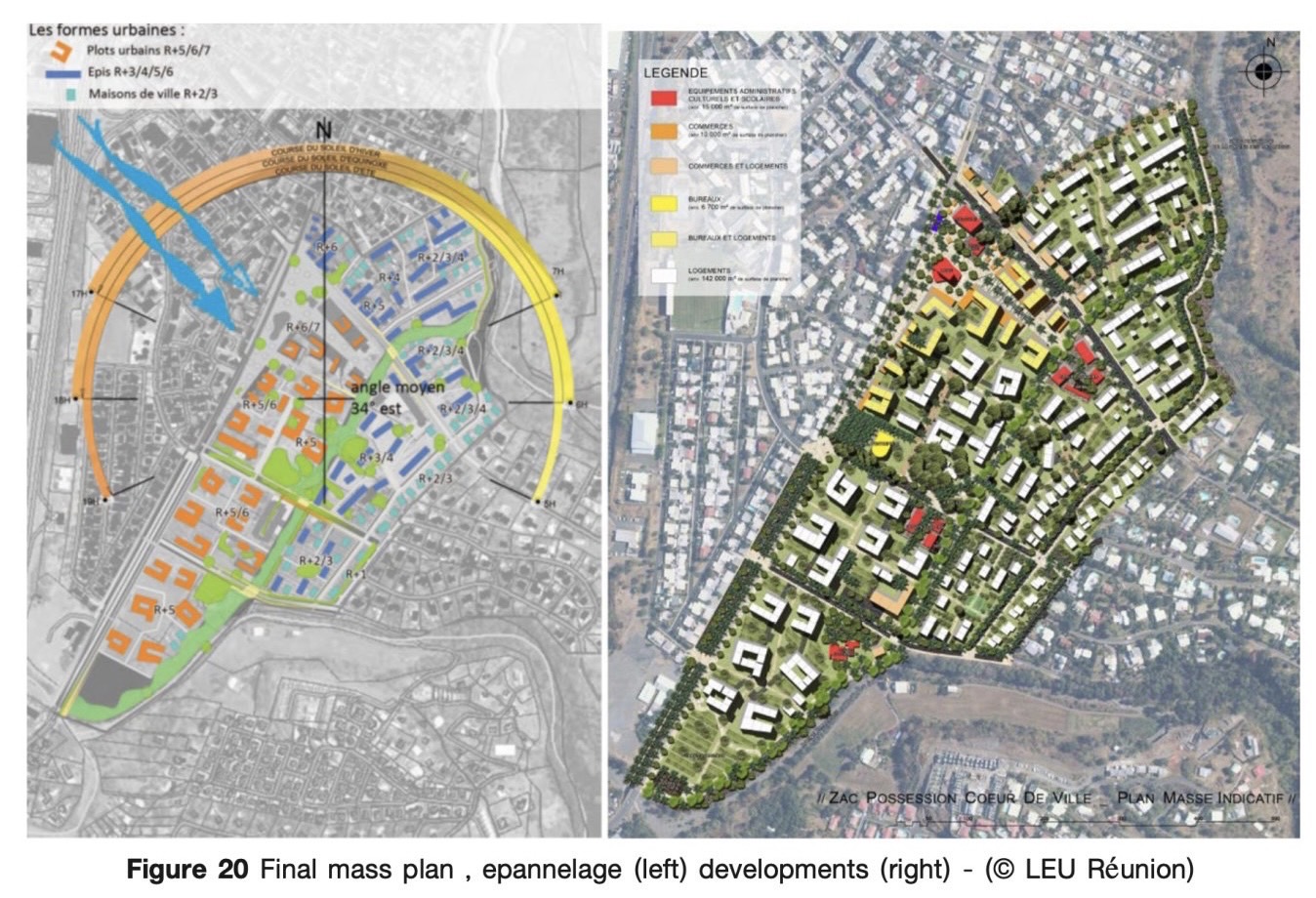Towards a Wind Urbanism in Tropical Environments
Main Article Content
Abstract
One of the conditions for the proper functioning of passive comfort in humid tropical environments is access to natural ventilation in buildings. This notion of access to natural ventilation has taken on its full meaning during the current health crisis.
Based on this observation established by a rich literature, we asked ourselves how to ensure the sustainability of the good functioning of natural ventilation in a humid tropical environment of a building in a built complex? This questioning led us to show the importance of the context through various dimensions: the chain of natural ventilation, the programmatic context, the climatic and geographical context, the regulatory context.
Taking these parameters into account has allowed us, in the context of a case study, the eco-district Cœur de ville de La Possession, on the island of La Réunion, to develop a new conceptual approach associating urban planning and aeraulic engineering from the beginning of the design process for maximum efficiency.
To this end, we initiated a new approach based on: co-design, the use of physical wind tunnel simulation at different scales, the integration of environmental, architectural and landscape recommendations at the scale of the district and of the buildings making up this district, in an enforceable urban planning regulation. This has enabled us, within the framework of this eco-district, to develop the concept of the right to natural ventilation, of the windy city and of the guarantee over time of the preservation of this potential.
The transcription of this approach in other eco-neighbourhoods in a tropical environment seems to us to be a major challenge to be considered and which could even be extended to other climatic zones, in the context of current global warming.
Downloads
Article Details

This work is licensed under a Creative Commons Attribution-NonCommercial-NoDerivatives 4.0 International License.
All material is licensed under the terms of the Creative Commons Attribution 4.0 International (CC-BY-NC-ND 4.0) License, unless otherwise stated. As such, authors are free to share, copy, and redistribute the material in any medium or format. The authors must give appropriate credit, provide a link to the license, and indicate if changes were made. The authors may do so in any reasonable manner, but not in any way that suggests the licensor endorses you or your use. The authors may not use the material for commercial purposes. If the authors remix, transform, or build upon the material, they may not distribute the modified material, unless permission is obtained from JARS. Final, accepted versions of the paper may be posted on third party repositories, provided appropriate acknowledgement to the original source is clearly noted.
References
Blanchard, B., Ferrucci, M., & Gandemer, J. (2010). Programme de développement d’une ville bioclimatique enLibye et approche expérimentale sur maquettes en soufflerie [Program for the development of abioclimatic city in Libya and experimental approach on models in the wind tunnel] (No. EN-10-103, pp. 40).
Blanchard, L. (2017). Premier bilan pour l’écoquartier de Bonne à Grenoble [First assessment for the Bonne eco-district in Grenoble]. Au service des territoires. http://www.caissedesdepotsdesterritoires.fr/cs/ContentServer?pagename=Mairie-conseils/MCExperience/Experience&cid=1250262978144
Colombert, M. (2008). Contribution à l’analyse de la prise en compte du climat urbain dans les différentsmoyens d’intervention sur la ville [Contribution to the analysis of various means to take into account urban climate in urban planning] [Doctotal thesis, Université Paris-Est]. https://tel.archives-ouvertes.fr/tel-00470536/document
Fry, M., & Drew, J. (1974). Tropical architecture in the dry and humid zones. R. E. Krieger.
Gandemer, J. (2011). Etude aérodynamique pour un urbanisme climatique du « centre-ville » de La Possession[Aerodynamic study for a climatic urbanism of the “downtown” of La Possession] (Rapport d’étude aéraulique).
Gandemer, J., & Picgirard, F. (2012). La ventilation naturelle en pratique [Natural ventilation in practice].ADEME.
Garde, F., Adelard, L., Boyer, H., & Rat, C. (2004). Implementation and experimental survey of passive designspecifications used in new low-cost housing under tropical climates. Energy and Buildings, 36(4), 353-366. https://doi.org/10.1016/j.enbuild.2004.01.045
Harzallah, A. (2007). Émergence et évolution des préconisations solaires dans les théories architecturales eturbaines en France, de la seconde moitié du XIXe siècle à la deuxième guerre mondiale [Emergence and evolution of solar recommendations in architectural and urban theories in France, from the second half of the 19th century to the Second World War] [Doctoral thesis, Nantes University]. http://www.theses.fr/2007NANT2001
Hyde, R., Upadhyay, A. K., & Treviño, A. (2016). Bioclimatic responsiveness of La Casa de Luis Barragán,Mexico City, Mexico. Architectural Science Review, 59(2), 91-101. https://doi.org/10.1080/00038628.2015.1094389
Lehmann, S. (2010). The principles of green urbanism : Transforming the city for sustainability. Earthscan.
Michelin, N. (2016). Manifeste pour une nouvelle fabrication de la ville [Manifesto for a new construction of the city]. AMC. https://www.amc-archi.com/article/manifeste-pour-une-nouvelle-fabrication-de-la-ville-par-nicolas-michelin,4722
Yassine, W., & Elgendy, K. (2011, september 14 ). Passive cooling: Responding to electricity demand in the UAE. Carboun: Advocating Sustainable Cities in the Middle East. https://www.carboun.com/sustainable-design/passive-cooling-responding-to-uae%E2%80%99s-soaring-electricity-demand/


